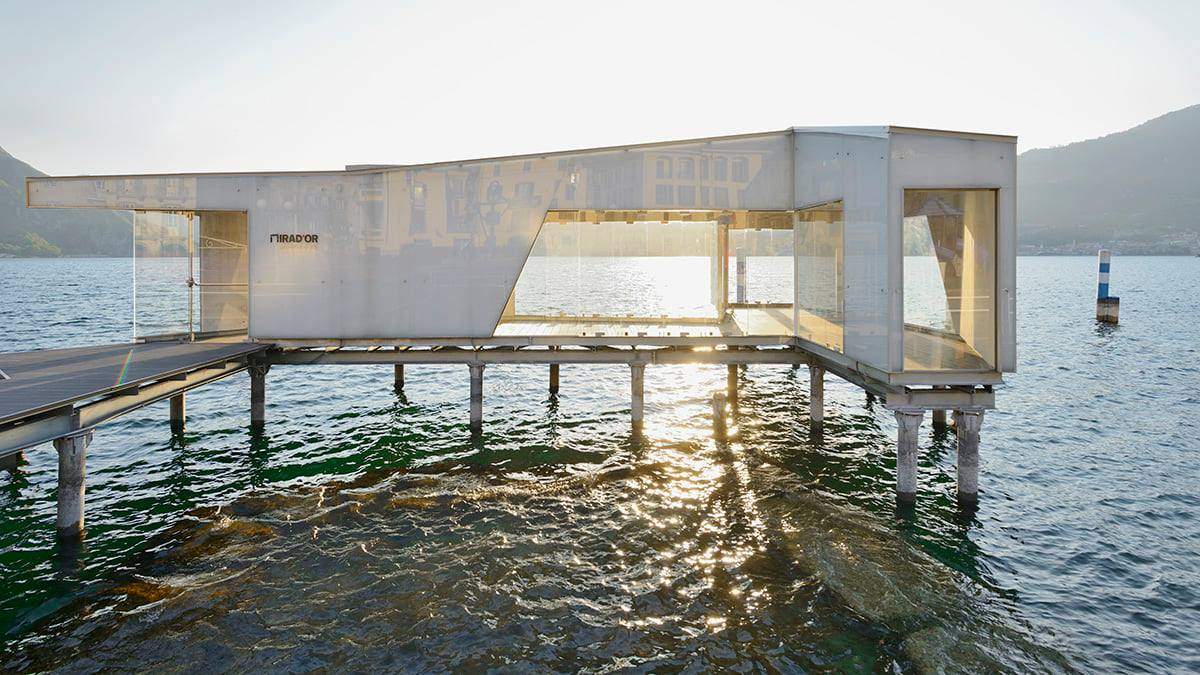A floating museum is about to open on Lake Iseo, with an intervention by Daniel Buren
The date set for the inauguration is April 24, after which, when the yellow zones will go out, it will be able to open to the public: we are talking about Mirad’Or, what many are calling the first “floating museum” on Lake Iseo, an exhibition space built on a pile-dwelling on the waters of the lake, in the village of Pisogne. The building, strongly desired by the municipality of Pisogne, is the brainchild of Gigi Barcella, an advertising executive and former creative director of Lowe Italia, and was designed by architect Mauro Piantelli of Studio De8 in Bergamo, who was inspired by Christo’s celebrated Floating Piers. The ISEO Serrature company also participated in the project as a funder.
The name, Mirad’Or, refers to several elements: first of all, it will be a “belvedere” over contemporary art exhibitions, since this will be the purpose of the floating gallery. It will then be a belvedere over the lake and its landscape, with reference to its history: in fact, Mirad’Or’s logo recalls the ancient washhouse around which the platform will be built.
“In Pisogne, a village that overlooks the Brescia side of Lake Iseo,” says Piantelli, "the municipal administration called us to reflect on the possibility of creating a small Belvedere, palafittato on the lake; this scenario gives us the opportunity to expand the reflection on the relationship between landscape and urban art. The small belvedere, Mirad’Or, also becomes a place for art installations. In his writing Sur quelques thèmes baudelaireiens, Walter Benjamin defines the concept of shock that humans receive from the use of technologies in the urban environment. Picking up on Freud, the German philosopher emphasizes how man is equipped with barriers to protect himself from external overexcitations, from too intense energies. It is the task of consciousness to protect man against the traumatizing effect of shock, which makes creation rare and innovation unaccustomed. Art is first of all a way of seeing, of re-aiming, the things of the world. Before the material work we need to re-discover the immaterial, to make full use of the other senses as well. The Mirad’Or is not an artificial correction of the shock, but rather the real possibility of a perception, of the world, protected and intimate. It is a public belvedere, a kind of camera obscura and reassuring space from which to peer out over the rippling waves of the lake and the landscape that hybridizes in the water, in that indefinite instant when earth and sky meet. It is a matter of light, reverberations and views. From Mirad’Or, the 2 most significant views of this place will be privileged: the Tadini Academy on the opposite front, to create a physical link between the 19th-century picture gallery and the new space for contemporary art, as well as the view to the southwest, toward Toline, where the lake is perfectly framed by the two promontories on opposite sides in an image of perfect transition between water-earth-sky."
The artistic direction of the gallery has been entrusted to Massimo Minini, owner of the gallery of the same name in Brescia, who will be joined by a group of experts in modern art. French artist Daniel Buren has been chosen for the first exhibition, and he has thought of an intervention with four large works that will dialogue with the landscape context: strips of fabric whose colors will live thanks to the daylight that will illuminate the works, while at night the latter will shine thanks to the action of moonlight. They will remain on display there until Sept. 30.
Pictured is the Mirad’Or. Credit Municipality of Pisogne
 |
| A floating museum is about to open on Lake Iseo, with an intervention by Daniel Buren |
Warning: the translation into English of the original Italian article was created using automatic tools. We undertake to review all articles, but we do not guarantee the total absence of inaccuracies in the translation due to the program. You can find the original by clicking on the ITA button. If you find any mistake,please contact us.





























